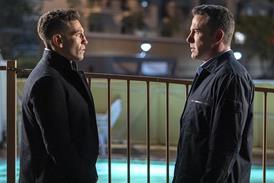Dir: James Cameron. US. 2003. 59mins.
For his first film since 1997's Titanic, Oscar-winning director James Cameron has chosen to return to the vessel that made him king of the world, this time with the large format 3-D cameras of Imax. It probably sounded like a money-spinner when this film was in the planning stages but there has been a lot of water under the bridge since Titanic's release, including 9/11 and the conflict in Iraq. The legions who made the romantic melodrama unsinkable at the box office will not be flocking to this film in the same numbers.
This is the second Imax film to visit the storied wreck (after 1992's Titanica) and while it features far more undersea footage and is technically superior - for one, it solves the lighting problems of shooting 12,000 feet below the ocean surface - it does not have the humanity of the first, which featured a living survivor. Rather, the new film is more of a Boy Scout adventure, and its nifty video-game aesthetic clashes with its affecting moments. Nonetheless, it will do respectable business in the long-playing large-format milieu where word of mouth can build slowly but steadily. Its first weekend in the US saw it take $1.4m from 97 sites for a strong take of $14,432 per site.
While technically a documentary, Ghosts Of The Abyss is more a recreation of a series of submarine dives conducted by Cameron and a team of experts, including a historian who has explored the backgrounds of the passengers and crew, and a zoologist who studies the marine life spawned by the rusting hulk. Along for the ride is Bill Paxton, the actor who played the wreck's fictionalised discoverer in the original Cameron film. His role is to represent the audience and provide some linking narration. Two other characters, of sorts, are the self-propelled robot cameras controlled by joystick by Cameron and an accomplice to explore areas of the ship inaccessible by manned submersibles.
The film is at its best when it shows in incredible detail the ship as it is today and then superimposes a ghostly live-action image of how it was before the evening of April 14, 1912. Sometimes these moments work very well - the telegraph operator's controls remain set as he left them - and sometimes they are forced to the point of cheesiness. Scenes from Cameron's Titanic serve to recreate the hysteria.
Perhaps the most sobering moment is the revelation that Cameron and crew were at sea filming this material when the attacks of Sept. 11, 2001 took place. Unfortunately, Imax cameras are too large and unwieldy to capture life's genuinely impromptu moments. This forces its non-actor subjects, including the director, to perform for the camera, creating a pervasive sense of artifice. The film's 3D image has depth but its action is strictly two-dimensional.
As a result the film's one actual actor stands out like a sore thumb. Paxton is accorded more screen time than the assembled experts collectively and yet his contribution amounts to frequent utterances of 'Wow, this is kind of spooky.' If Cameron had convinced Leonardo Di Caprio to take the dive, then maybe we'd be talking.
Prod co: Walden Media, Earthship Productions
US dist: Buena Vista
Int'l sales: Summit Entertainment
Prod: James Cameron, Chuck Comisky, Andrew Wight
Cinematography: Vince Pace
Ed: Ed W Marsh, Sven Pape, John Refoua
Prod des: Martin Laing







![The Brightest SunScreen[Courtesy HKIFF]](https://d1nslcd7m2225b.cloudfront.net/Pictures/274x183/3/5/0/1448350_thebrightestsunscreencourtesyhkiff_312678.jpg)











No comments yet